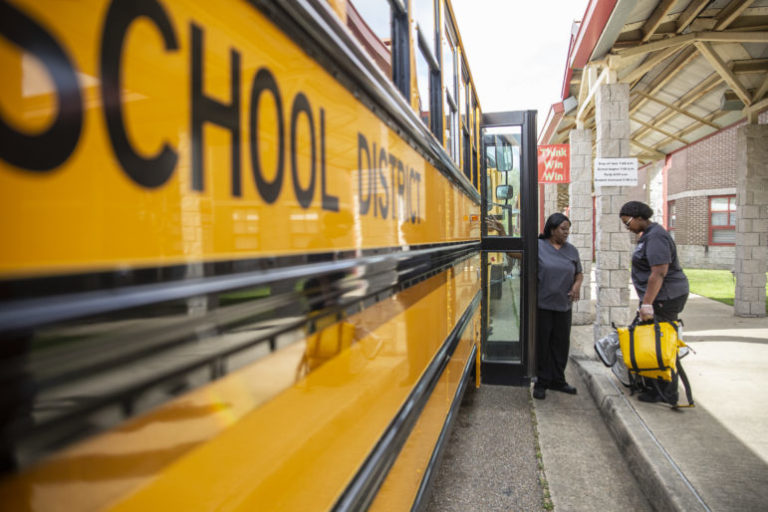

Eric J. Shelton/Mississippi Today, Report For America
Vicksburg Warren School District employees prepare to make food deliveries to students in the school district Wednesday, March 18, 2020.
The coronavirus pandemic has closed school buildings and forced educators to rethink how to deliver instruction. But a windfall of federal funds designated for Mississippi’s K-12 and higher education institutions may change the way schools offer classes and other resources.
On March 27 President Donald Trump signed the Coronavirus, Aid, Relief and Economic Security Act to provide much needed financial assistance to states affected by the coronavirus pandemic. It contains $2 trillion in aid, and $30.75 billion of that is designated to states for education.
The Education Stabilization Fund is split into categories: The Governor’s Emergency Education Relief Fund, the Elementary and Secondary School Emergency Relief Fund, and the Higher Education Emergency Relief Fund. A separate pot of money is designated for states with the highest coronavirus burden and for the Bureau of Indian Education.
How and when this money is spent may change, because the Legislature is currently in a political battle with the governor to strip him of his sole spending authority of stimulus dollars and have the funds flow through the appropriations process rather than be dispensed by the governor.
Governor’s Relief Fund (GEER Fund)
A letter from Secretary of Education Betsy DeVos to governors said this “extraordinarily flexible emergency block grant” allows governors to determine how to meet the needs of students and schools, postsecondary institutions and education organizations. The letter specifically stated charter and non-public schools are included.
“My Department will not micromanage how you spend these funds, but I encourage you, at a time when so many school boards, superintendents, and institutions of higher education have had to close their brick and mortar campuses for the balance of the school year, to focus these resources on ensuring that all students continue to learn most likely through some form of remote learning,” the letter read.
While these monies are to be spent at the governor’s discretion, the Mississippi Department of Education told Mississippi Today it is collaborating with the governor on the use of these funds.
Last week, Reeves said he intended to use some of the CARES Act funds to help with distance learning.
“We know that this virus could come back, and distance learning may become a more typical part of our education system. We also know that there are families without access to the tools that are necessary for distance learning,” Reeves said. “I have a plan to utilize CARES Act funds to help fix that, and it will be a top priority. Support for teachers, schools and especially parents will be a critical part of our recovery.”
Elementary and Secondary School Emergency Relief Fund (ESSER Fund)
These dollars go directly to the Mississippi Department of Education, which will then subgrant the funds to school districts. The funding amount the state received was calculated using the same formula used to determine Title I funding, which are federal dollars given to schools with a high number of low-income students enrolled.
The district by district allocation amounts are not available yet, according to a department spokesperson, but department officials are working on releasing guidance documents to schools on how to spend the money.
“I think all districts, particularly those that are struggling to provide distance learning really need to be thinking very carefully about how this money should be spent,” said State Superintendent Carey Wright. “The important aspect of this that we’re still working on is that there is a tremendous amount of reporting responsibility back to the federal government about how this money is spent.”
Higher Education Emergency Relief Fund (HEERF)
These funds go directly to colleges and universities. You can view the allocations to all colleges and universities here. Institutions are required to use at least half of the funds they receive to provide emergency financial aid grants for students who have been affected by the pandemic. This means the funds can be used to help students afford food, housing, course materials, technology, health care or child care. The other half of the funds can be used by and for the universities “to cover any costs associated with significant changes to the delivery of instruction due to the coronavirus.”
Community colleges also receive these funds:
Kelsey Davis Betz contributed to this report.
The post Mississippi to receive millions in education CARES Act funds appeared first on Mississippi Today.
- How to educate your kids now about creating long-lasting healthy money habits - December 29, 2025
- Mississippi-based photographer’s unseen Civil Rights images are shown in Alabama, seven decades later - December 28, 2025
- Are legislators keeping their promise to follow the Mississippi Constitution? - December 28, 2025